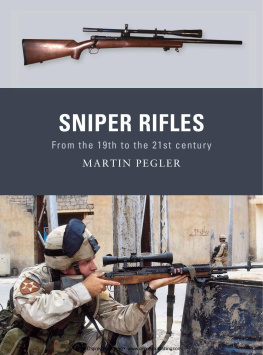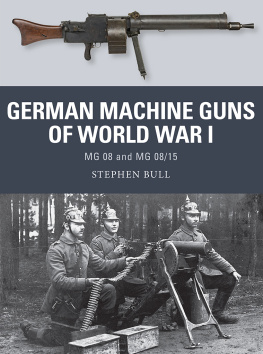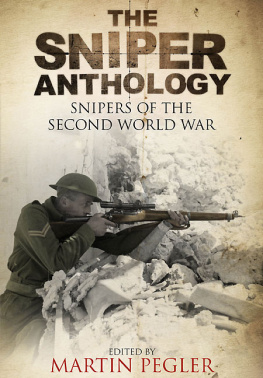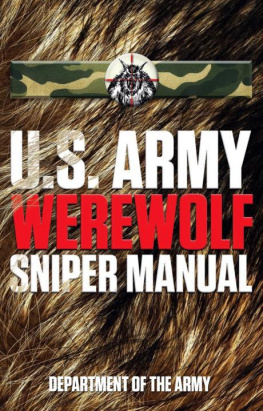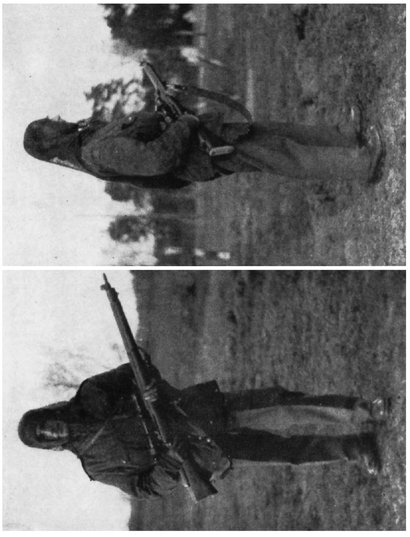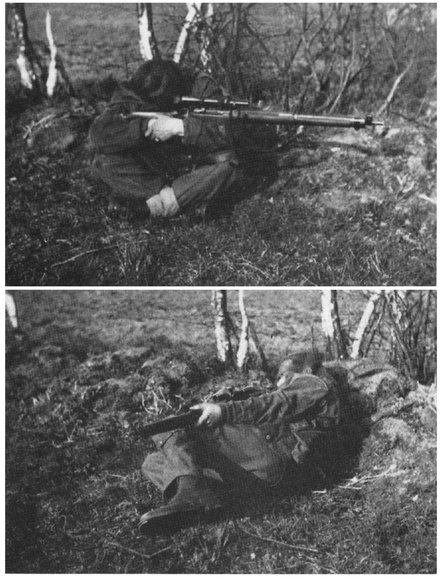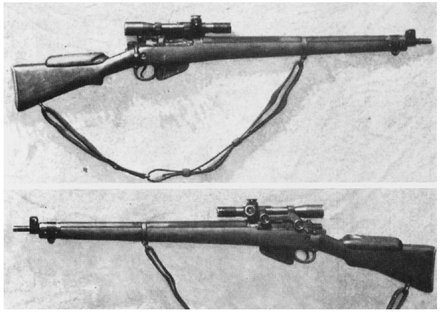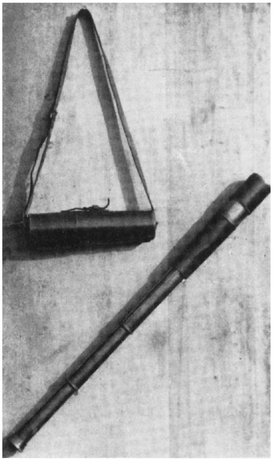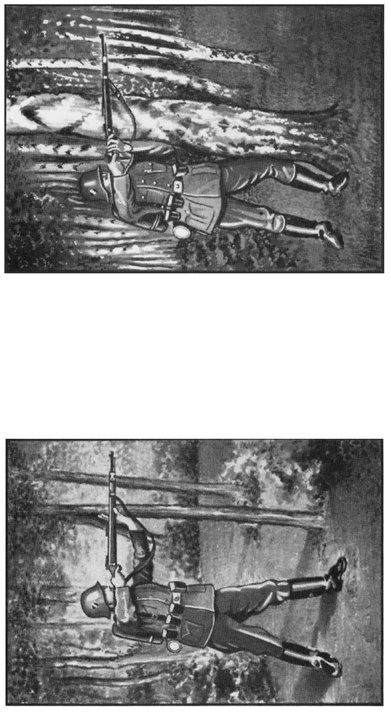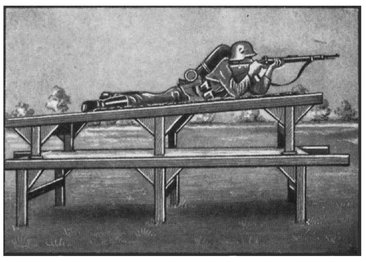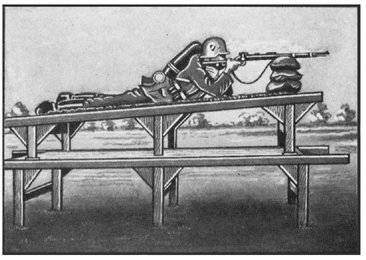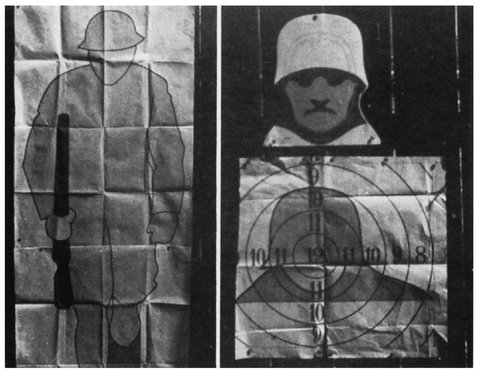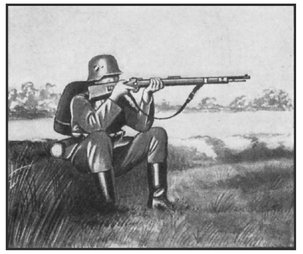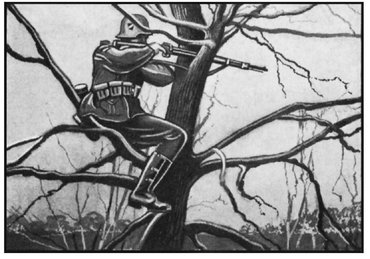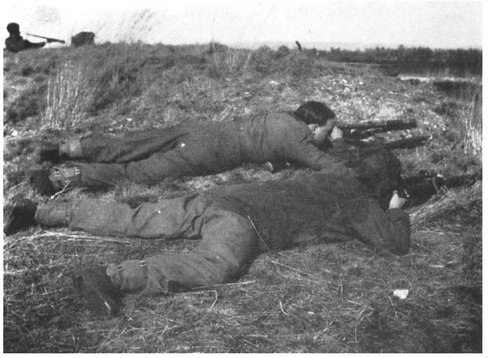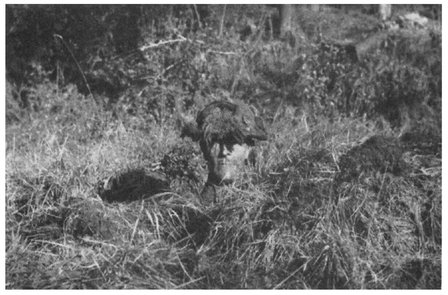BRITISH SNIPER EQUIPMENT
Showing telescope, binoculars, compass, watch, head and face camouflage veil, camouflage (Denison) smock and the No. 4 telescopic sighted Sniper rifle.
BRITISH SNIPER
Note pockets in smock, telescope slung across back and use of veil. Rifle sling kept slack. Smock fastened at bottom by strap which passes under crotch, preventing smock from riding up at back.
BRITISH SNIPER
Two rather unconventional but very good shooting positions for the sniper. Upper is a sitting position well known to American shooters and often used. Lower is a variation of the back position (often used in British match rifle competitions), and a good one to drop into for a quick shot from sloping ground or to fit into a small shell hole or hide.
BRITISH SNIPING RIFLE
The standard No. 4 (T) sniper rifle.
BRITISH SNIPING RIFLE
A modified No. 4 Sniper rifle, with pistol grip and cheekpiece style of butt of Canadian make. Has thick rubber pad in place of metal butt plate.
BRITISH SNIPER TELESCOPE
This is the Scout Regiment telescope, a three-draw, bulky, clumsy and heavy glass but a splendid instrument in the hands of a skilled observer. It magnified about 20 diameters, with a field of view of but 1, and if properly used could penetrate deep shadows, show up enemy camouflage and reveal badges of rank with ease. Under suitable conditions of light it would show up troop movements to a distance of ten miles. Generally, this big telescope took over when the lower powered binoculars gave out.
FIRING POSITIONS IN THE GERMAN ARMY
Standing positions as taught by the German Training Manuals. Note that they make use of available trees as a rest for the rifle and as cover, wheneve possible to do so.
Prone position as taught by the German manuals. Note that the left arm is not extended to any degree.
Another prone position utilizing sandbag rest for the rifle. Note the position of left arm, with hand grasping the butt of the rifle.
EUROPEAN RIFLE RANGE TARGETS
Left is a German silhouette target of a British tommy running. These targets were found in many different shades of colouring.
Right shows two different targets; top is a British Hun Head type of target; bottom is the center section of the German range classification 300 meters target.
Sitting position, as given in the German manual, and a very poor position according to American teachings and practice. Note in all these illustrations that the Germans teach the recruit to lay his thumb across the grip of the stock and not alongside of it.
GERMAN KNEELING POSITION
A very poor position, according to American ideas and practices.
Shooting from a tree, as taught by the German manual. Note that rifle rests in crotch of tree while left hand supports the butt of the rifle.
The big telescope afforded a terrific advantage to the British sniper. (The observer in above sketch is using the telescope case as a head rest.)
MOVEMENTAS TAUGHT AT THE SNIPING SCHOOL
When crawling on the stomach, or the elbow and knees, the best method of carrying the rifle was to grasp the sling with right hand close to forward swivel, muzzle to front, and allow the rifle to lie along the forearm, as shown in sketch above.
SNIPER PAIR IN TRAINING
one shooting, one observing with telescope... around cover.
Note the tremendous difference the sniper smock and camouflage veil make in a mans merging into the ground, compared with the battle-dressed and bareheaded observer. It is especially interesting to note how the khaki of the snipers trousers stand boldly out against the groundthe smock and veil of dark matt shades tone into the ground much more than the khaki trousers.
DUMMY HEAD IN POSITION
At a range of 400600 yards this target would call for considerable finding; many enemy snipers would waste ammunition shooting at such a dummy head and at the same time give their own position away.
DUMMY HEADS
Dummy heads were used a great deal in World War I, and although their appearance at our Sniping School occasioned some derisive comment (they were dubbed old fashioned) there are factual accounts of their successful use in World War II.





